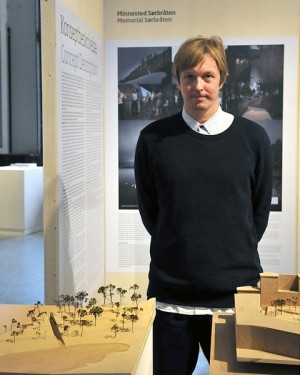NEWS ANALYSIS: Tapped to memorialize the greatest trauma of Norway’s recent history, Swedish artist Jonas Dahlberg has a big job ahead of him. His winning proposal for memorials to the terrorist attacks of July 22, 2011, which involves a “cut” through land across from the terror-hit island of Utøya that will bring parts of the land back to central Oslo, promises a compelling network of spaces for the nation to grieve and reflect together. It has also upset Utøya’s neighbours, though, who call it a “rape” of the landscape.

Carrying a price tag of NOK 27 million (nearly USD 4.5 million), Dahlberg divided his proposal into three parts: “Memory Wound,” “Time and Movement” and “Dialogue for the Future.” He said he “wanted to create an incurable wound in nature,” when his proposal recently won a state-sponsored competition.
The “wound” is meant to represent the brutality and permanence of the loss suffered by victims of the July 22 attacks. Dahlberg’s dramatic proposal calls for cutting off part of land at Sørbråten, just across from Utøya, and excavating a canal-like water passage through it. Visitors will be able to enter underneath one side of the “wounded” landscape and look across the water where, on the other side, the names of those who died will be written in stone.
The “wound” seems to have opened up new ones for those living in the area just across the water from Utøya. They don’t want to see the land cut off as part of the memorial, and claim they’ll be forced to see the “wound” every single day. Some, including Morten Jensen who’s leading a social media effort against the project, are trying to get over the trauma of July 22, and don’t want to live with daily reminders of it. A group of around 600 persons, who also worry about the crowds the memorial might attract to their small community, wants to halt what they call “an enormous assault on the nature that the state has approved.” An open meeting between state officials and the group is set for later this month.
The excavation is predicted to yield roughly 1,000 cubic meters of stone, dirt, and plant life. Rather than simply discard this now hallowed earth, Dahlberg’s suddenly controversial proposal will bring it all back into Oslo’s city-center. The material will then form the basis for a memorial walk around the government buildings where the lone ultra-right-wing Norwegian terrorist launched his attacks with a bomb that devastated the state government’s headquarters.

Trees, bushes, dirt, and stones from Utøya will find a permanent home in the heart of the nation’s capital, where the city’s inhabitants and government workers will be able to take a shaded stroll among the flora of Utøya. The repurposing of the island land within the city center creates a powerful bridge between the two sites of trauma and pain that are separated geographically by some 40 kilometers.
Ground zero of the July 22 bombing was the so-called høyblokka, a tall modernist building from 1958 that housed the Offices of the Prime Minister and the Norwegian Ministry of Justice. Since the attacks, debate has swirled over the fate of the historic building, which was badly damaged but is still standing. Many government officials have made economic and technical arguments for the building’s outright demolition, with one recent government report arguing that a clean start could save between 400- and 800 million kroner in public funds.
The country’s architectural community and historic preservationists see it differently. The National Association of Norwegian Architects (Norske arkitekter landsforbud) has argued strongly for the building’s partial or complete preservation on both historical and aesthetic grounds. Nils Herland, a Norwegian architect whose offices are right around the corner from the government complex called Regjeringskvartalet, agrees.
“In general I think most architects love høyblokka,” Herland told News in English, “including me.” By envisioning høyblokka intact, Dahlberg’s proposals for both a temporary and permanent memorial will likely please those in Norway’s architectural communities who want to see the building live on.
Dahlberg’s track record
Previous work by the 43-year-old Dahlberg, who lives in Stockholm, seems to set him up well for the monumental task of memorializing a nation’s pain. His work has often mixed visual art, architecture, and sound elements to create dynamic narrative explorations of history and memory.
In 2012, for a project called “An Imagined City,” he transformed the old post office in Stockholm into an interactive environment that encouraged visitors to rethink the limits and possibilities of city architecture. In 2013, he delved more deeply into the psychological and cinematic aspects of space in his ambitious Hall of Mirrors exhibition at the Gothenburg Konsthall. In these instances and others, Dahlberg has continuously sought after the complex and mysterious relationships between public and private space, memory, and the change that time inevitably brings.
These qualities will all be put to the test now that Dahlberg has been selected to shepherd a national memorial for Norwegians who continue to grapple with the trauma and loss they experienced nearly three years ago. Svein Bjørkås of the state art agency KORO, charged with creating the national memorials, told state broadcaster NRK on Friday that “the vast majority has been positive” to Dahlberg’s design, not just the jury that selected it, but he stressed that “we want to hear from those who have different opinions.”
Bjørkås added that it’s “neither prohibited nor unreasonable” to have different views around a national memorial. He defended the process that led to the choice of Dahlberg’s design for a memorial, which is supposed to be completed by July 22, 2015.
newsinenglish.no/Drew Snyder, with Nina Berglund

